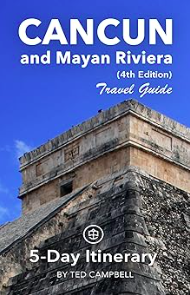Blog Archives
All about the Mexico City Airport: Benito Juarez International (AICM)
Tips and practical information for Mexico’s busiest airport
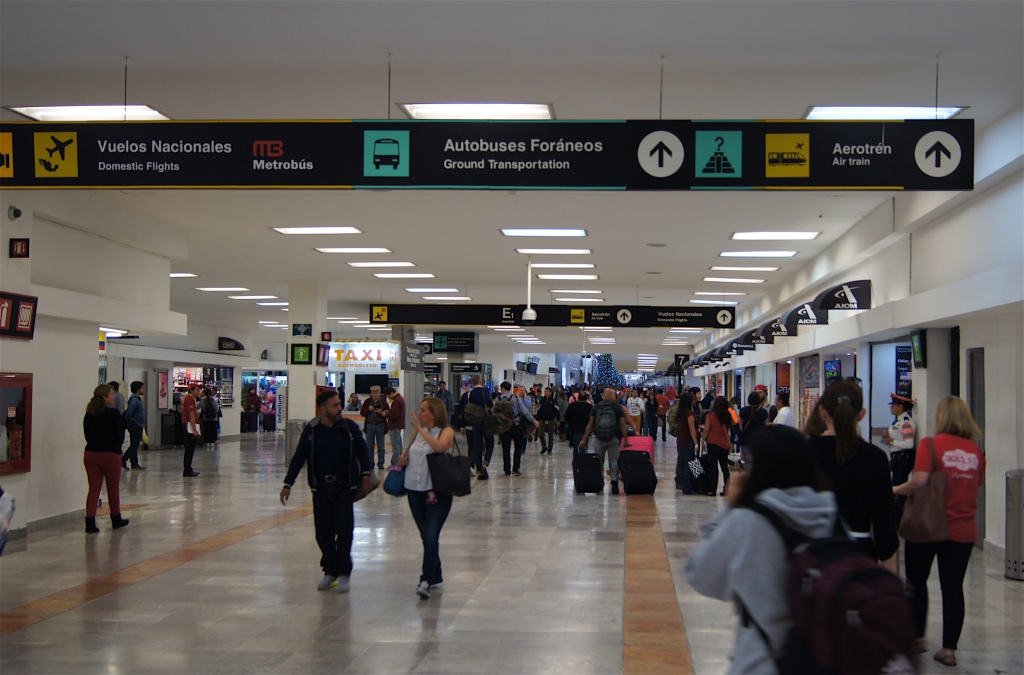
Mexico City now has two airports. Benito Juarez International is the older one, and it’s located in the city center. It goes by AICM, which translated to English is the Mexico City International Airport.
The newer and much larger Mexico City airport is Felipe Ángeles International Airport, with the acronym AIFA. If you have a choice between them, choose AICM, because it’s so much closer to the city.
The Toluca International Airport is often considered a third option for a Mexico City airport. It’s also far away, at least an hour by bus or taxi, but it has the advantage of being very small and almost never busy.
This article is about what’s still the most used airport in Mexico City, Benito Juarez International (AICM).
From AICM you can take a connecting flight on one of Mexico’s discount airlines to practically any other part of the country. Or you can take a short bus or subway ride into Mexico City, where many great adventures begin. After exploring the city, continue onward in a bus or a rental car.
Like any major airport anywhere in the world, Benito Juarez International is big and confusing, but there’s nothing to be worried about. A little knowledge and preparation goes a long way. After a long flight, it’s no fun walking around in circles with your heavy baggage and nowhere to go, no pesos, and no Spanish skills.
The biggest problem with the airport is that it’s way too small for a megacity like Mexico City, which is why the second airport was built (amid serious controversy).
It may takes a long time for you to get off the plane. You might have to walk down a staircase on a corner of the runway and then take a bus into the terminal.
The upside to being close, besides getting into town quickly, is that it’s common to fly right over the center of town, with great views of Chapultepec Park, the skyscrapers on Reforma Avenue, and the zocalo surrounded by the cathedral and government palaces.
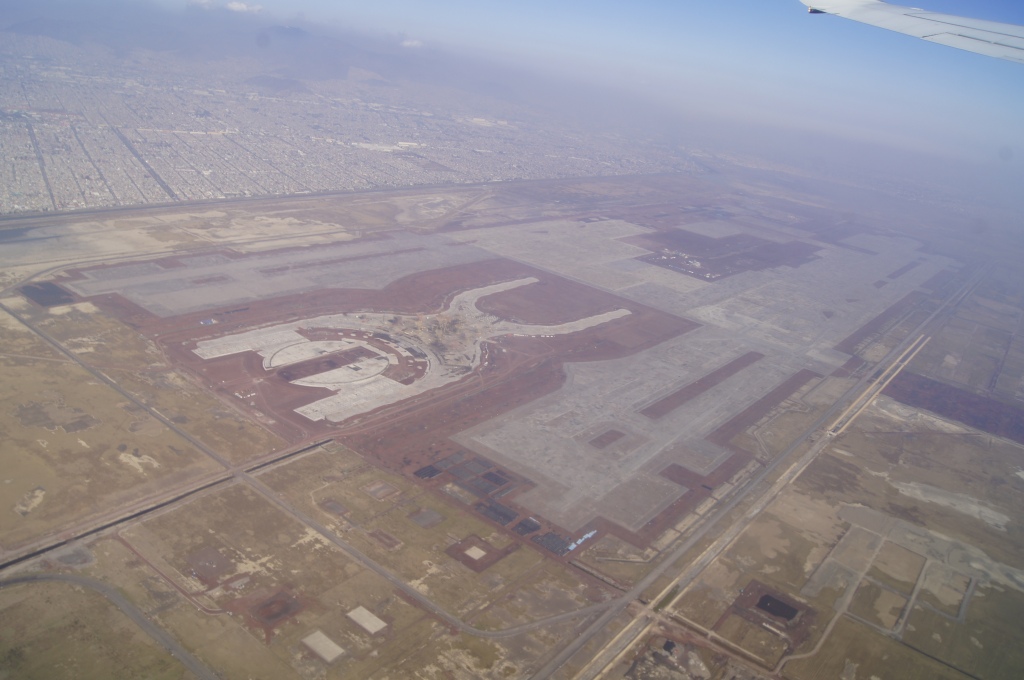
So, although understanding the Mexico City airport is fairly straightforward, at a minimum you should learn about public transportation routes and schedules, how to get money, and procedures for customs and immigration. Figuring these out for my recent trips to Russia and South Africa was enormously helpful, even though it required a lot of online research beforehand.
That research gave me some insight into what it’s like for first-time travelers to Mexico to arrive by plane in Mexico City. So, with that in mind, here’s what you need to know to successfully navigate the Benito Juarez International Airport.
Choose a good arrival time
The first step is to choose your flight carefully so you arrive while public transportation is still running. But if you don’t mind paying for a taxi to your hotel, then it really doesn’t matter what time you arrive. In this case, review the policies of your hotel for the earliest time you can check-in or if you must let them know before arriving late at night.
(I’ll write about getting hotels in Mexico in another post, but for now, if you’re still looking for a place to stay, check out all the options on websites like trip.com and booking.com)
If you want to use public transportation, don’t arrive before 6 AM or after 8 PM. Although the metro (subway) and the metrobus (local buses that run on a fixed route) do run later, usually until around 11 PM, it’s not a good idea to walk around Mexico City in the dark while dragging your baggage from the bus or metro stop to your hotel.
Downtown is reasonably safe (at least in the daytime), but there’s no need to tempt fate.
Also keep in mind that buses from the Mexico City airport to other nearby cities stop running around 10 PM, and you may need up to an hour to get through immigration and customs, depending on how busy they are.
If you don’t mind sleeping on the plane, the best time to arrive is between 6 and 7 AM. You can take public transportation and beat Mexico City’s insane rush hour traffic, which really gets heavy after 7. Another good time to arrive is between 10 AM and 1 PM. You’ll miss rush hour when traveling into the city, and you’ll get to your hotel just in time for check-in.
If you arrive in the morning, make sure your hotel doesn’t charge for an early check-in. Check-in for most hotels is around 2 PM, but if the room is ready they’ll probably let you in early. If not, then leave your bags behind the front desk and go out for a long breakfast.
A second consideration when planning your flights is whether you’ll transfer in Mexico City for another destination in Mexico. You’ll clear immigration and also customs there before you fly to your next destination. This could take 30 minutes or several hours—or even longer on a busy Mexican holiday. Make sure you have enough time between flights.
There are two terminals at the Mexico City airport, and depending on how busy it is, getting from one to the other could take around 30 minutes. They are too far apart to walk—you take a little train between them.
Which terminal your flight arrives at depends on which airline it is. So if both flights are on the same airline, you probably won’t have to change terminals. But if they are different airlines, include extra time when considering your layover.
Save your tourist card
Like for most countries, you’ll get the tourist/immigration and customs cards on the plane. They are in Spanish and English, so filling them out is easy. If you have any questions, ask the flight attendant.
You might find a few typos—for example, at the moment both the top and bottom parts say that it is the arrival card. The bottom part is actually the departure card, so fill in all the information except for the flight number.

Immigration
Once the plane lands, all the passengers will be herded toward the immigration area, called migración in Mexico. Get in the line for foreigners, not for Mexican citizens.
You’ll give the tourist form to the immigration officer, who will stamp the bottom part, write the amount of time you are granted to be in the country (usually 180 days), and give it back to you. Save this card—you’ll need it to leave Mexico, and if you don’t have it you’ll be fined about $30 USD.
You’ll probably be asked about the purpose of your trip (tourism), how long you plan on staying, and where you’ll be staying (your hotel or other destination), but probably little else.
It’s rare that they ask to see your return ticket (which can be common in other countries, like the U.S.), but regardless it’s good to have a printout of your return itinerary if you have one, just in case.
Customs
The customs area is next to the baggage claim in both terminals. After getting your bags and waiting in line, you’ll hand the customs form to the officer and then push a button. Above the button you’ll see either a green or red light. The green light means that you can enter, and the red light means you’ll be searched.
The one time I pushed red I had the maximum allowable amount of liquor (three liters at the time, but this may change) in a duty-free shop bag and three more bottles in my luggage. As eager as I was to get out of the airport, I stood back patiently and answered all of the officer’s questions while she lined up the bottles on the metal counter. She got about halfway through my bag and let me go, no problem.
So take my advice—be as respectful and patient as possible. (This goes for all Mexican authorities.) DO NOT complain or tell them you’re in hurry, which will only annoy them and cause them to give you a hard time.
Terminal 1 or Terminal 2?
As I mentioned above, there are two terminals at the Mexico City airport, which are far apart on opposite sides of the runways. It won’t be obvious which terminal you are in upon arrival, so if you need to make a connection, ask a flight attendant on the plane or an officer in the baggage claim.
The terminals are not divided by international and domestic; different airlines use different terminals. Generally speaking, Aeromexico and Delta use Terminal 2 and all the rest will be at Terminal 1, but there are exceptions to this.
A train called the Autotrain travels between the terminals. Save your boarding pass to use it because they won’t let you on without one.
Changing money
Exchange rates in airports are typically terrible all over the world, including the Mexico City airport. Don’t use the ones when you are still inside the baggage claim area, but wait until you clear customs.
At each currency exchange booth you’ll see two different numbers for U.S. dollars and other major currencies: buy and sell. The smaller the difference between them, the better the rate. For example, if “buy” is at 20.54 and “sell” is at 20.40, it’s a good deal. But if “buy” is at 22.00 and “sell” is at 18.00, the rate is worse.
It’s crucial to have an idea of the exchange rate before you arrive so you can compare rates at the different booths with the official rate. Before your trip, check exchange rates online, such as at this website: http://coinmill.com
Make some notes about how much your home currency is worth in pesos, so you aren’t trying to make rushed calculations after a long flight. Make a sheet with notes like this:
- $10 USD = 190 pesos
- $20 USD = 380 pesos
- 100 pesos = $5.30 USD
- 200 pesos = $10.60 USD
(These rates are only examples.)
By the way, exchanging money in downtown Mexico City is easy, so if the rates are bad at the airport, only get what you need for transportation and a meal.
Or, for a generally better exchange rate, withdraw from a bank ATM. Many are scattered throughout both terminals, including near the exit for the metrobus in Terminal 2. Look for ATMs with international credit exchange symbols on them, like Cirrus or Interac, and match those symbols to the ones on your card:
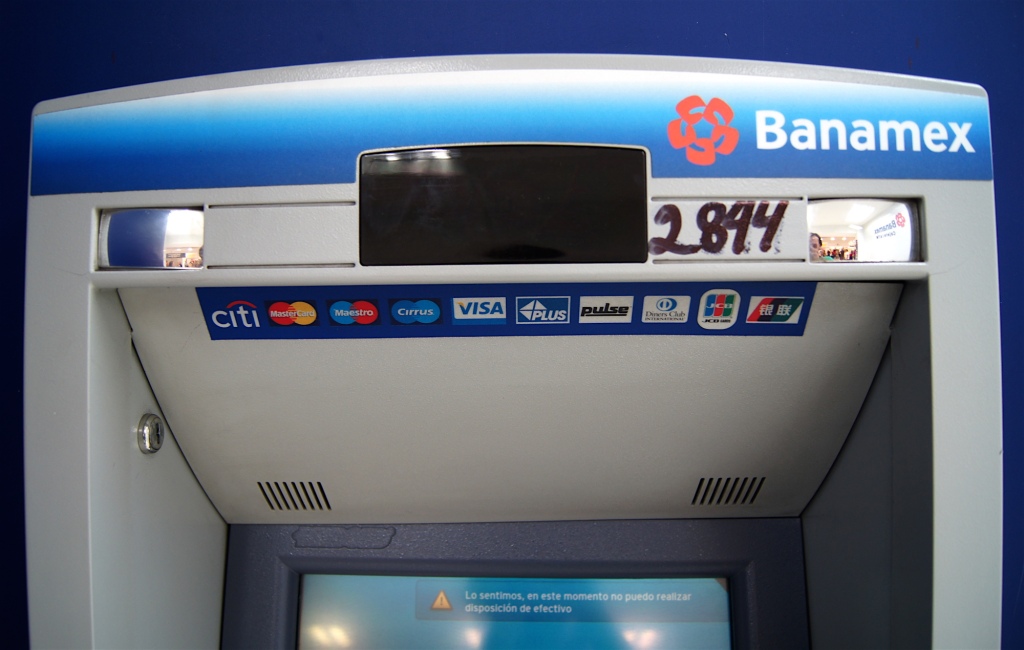
Common banks in Mexico, all of which have ATMs in the Mexico City airport, are Bancomer, Banamex, Banorte, Santander, HSBC, and Scotiabank.
For more about managing your money in Mexico and Latin America, read this article.
Renting a car
Unless you’ll immediately drive to a nearby town or visit an unusual part of the city, I don’t recommend renting a car in Mexico City.
Driving around is a bad idea for three reasons: traffic, parking, and confusing road signs that make getting lost easy. Driving through the wrong neighborhood could get you carjacked or worse. Plus, you can get to all the major tourist spots by bus, metro or metrobus.
But if you want to rent a car, you can do it at the many booths near the taxi stands, although you can often get a better deal online. All the usual international companies are there, like Enterprise, Budget, etc.
If you reserve online, be aware that the insurance offered by third-party websites is not valid in Mexico. When you go to pick up the car, the price will double or even triple when they add insurance. To avoid this, arrange car rentals directly on company websites, and read all that boing fine print.
Picking up a car at a major airport can take a long time. First you get in line at the booth inside the airport and then take a shuttle to the car lot, where you fill out all the paperwork and wait for the car to be ready. Then, once it’s ready, you go around the car inspecting for previous damage, and finally sign the contract.
This means that you shouldn’t expect a fast process when picking up a car at the Mexico City airport. Plan for the extra time. Fortunately, dropping the car off before departing usually only takes a few minutes.
Ground transportation
Besides renting a car, there are three better options to get into downtown Mexico City: a taxi, the metrobus, and the metro (subway).
Taxis take you anywhere; the metrobus is a good option in the daylight hours to get to the zócalo (central square) or elsewhere in the centro historico or nearby neighborhoods like Condesa or Zona Rosa; and the metro goes practically everywhere and is by far the cheapest and most confusing.
Also, if you’ll travel by land to another city in Mexico, many direct buses leave from both terminals.
Taxis
Using a taxi is the fastest, easiest, and most expensive option. For safety’s sake, do not flag down a taxi outside the terminals, but use a taxi stand inside the airport.
Ignore anyone who approaches you offering a taxi—go right to the stands. Many obvious ones are in both terminals and prices should be similar, if not the same. Confirm that you’ll be in a regular car (a sedan, the word in Spanish and English) and not a big passenger van, which costs more.
At the time of writing, getting downtown (the centro historico) costs about 230 pesos (about $12 USD). If you want to pay with a credit card, look for Mastercard, Visa or American Express stickers on the booth window. Or get some pesos first—don’t pay in U.S. dollars, as the exchange rate will be ridiculous.
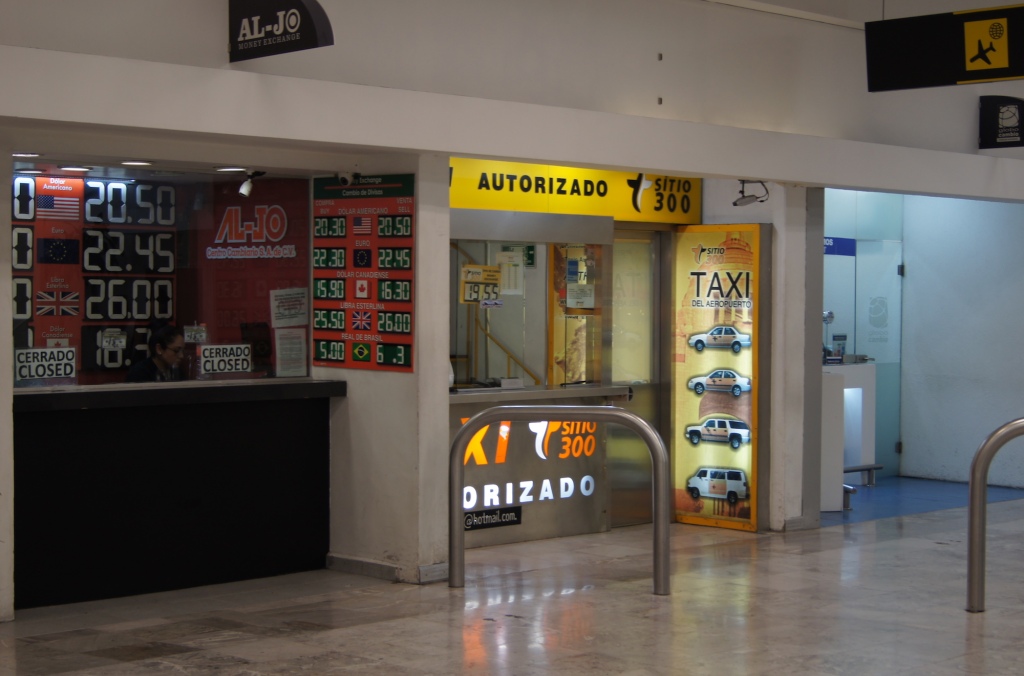
The price is determined by neighborhood, so have the full address of your hotel ready. You’ll pay at the stand and then receive a slip of paper to give to a person by the line of taxis waiting outside. Once in the taxi, tell the driver the specific address of where you’re going—again, having it written down is essential, especially if you don’t speak Spanish.
The price of a taxi is the same no matter how many people use it, so try to share with any friends you make on your flight who are traveling to the same part of the city as you.
Metrobus
This is a good option if you’re going downtown and don’t mind dragging your luggage around. There’s plenty of space for it on the bus, although the buses tend to get quite crowded soon after leaving the airport.
The metrobus line for the Mexico City airport is Line 4. Check out the map to find the stop closest to your hotel and if it’s within walking distance.
The metrobus leaves from the ground floor in each terminal, close to where you exit customs. It leaves from Door 7 (Puerta 7) in Terminal 1 and Door 3 (Puerta 3) in Terminal 2. Look for the MB symbol on signs hanging from the ceiling.
Once outside, look for MB symbol on a sign—that’s the bus stop—and wait in line for the big red bus.
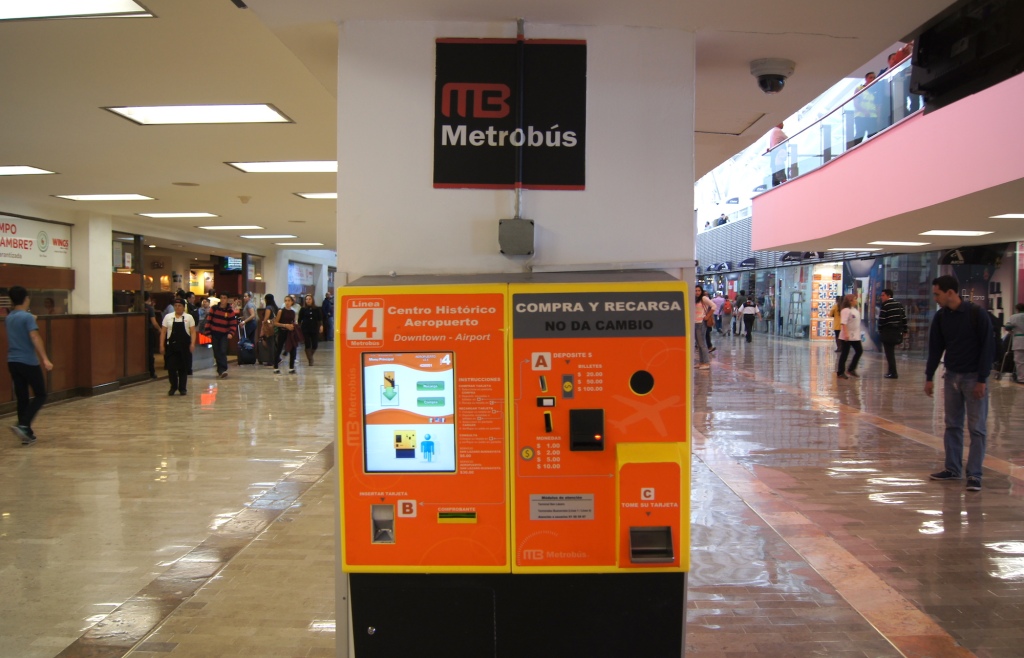
To pay, buy a card from a machine inside each terminal near the door to the bus stop. The minimum is 40 pesos plus 10 for the card, so that’s 50. The machine accepts 20, 50 and 100 bills, but it doesn’t give change, so buy something from the convenience store OXXO if you only have big bills.
From either terminal it takes about 30 minutes to get downtown. If you don’t have hotel reservations, but plan on walking around looking for a hotel (there are many around the zócalo), get off at Bellas Artes—you can’t miss it.
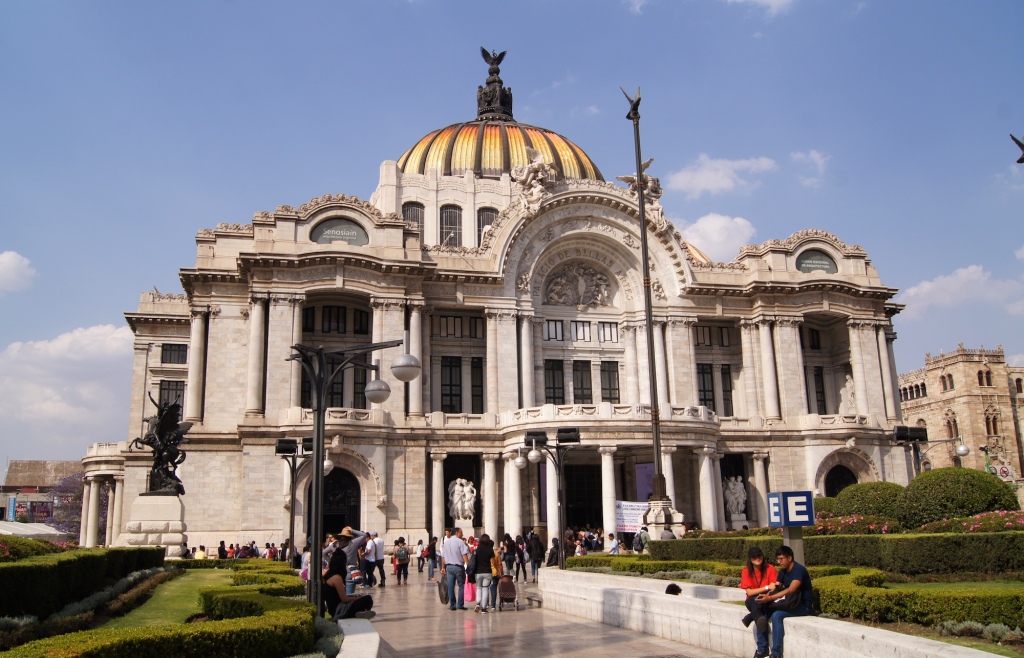
Metro (the subway)
The Mexico City metro is super cheap at 5 pesos per ride, and although it’s safe enough, it definitely isn’t a good idea for anyone who has never taken a subway before or has a lot of luggage. You need to be able to read the map, be comfortable with transfers, and keep an eye on your bags at all times.
The metro leaves from Terminal 1. Walk outside, turn left, and keep walking until you see the entrance.
The name of the stop is Terminal Aérea, and it’s on an out-of-the-way line, so you’ll probably have to transfer at least once. Get a copy of the metro map beforehand and plan your route. Not all stations have maps posted and they aren’t always available when you buy tickets, although you can try asking for one.
As you can see, the Terminal Aérea stop is on the yellow line (on the far right on the map), which doesn’t go downtown. Only a stop or two away, however, are transfers to the major lines that cross the city, including the pink line through downtown.
To look for hotels in the historic center, get off on the Pino Suarez or Isabela la Catolica stops on the pink line, and ask someone to point you in the direction of the zócalo. You’ll pass many discount hotels on the walk there.
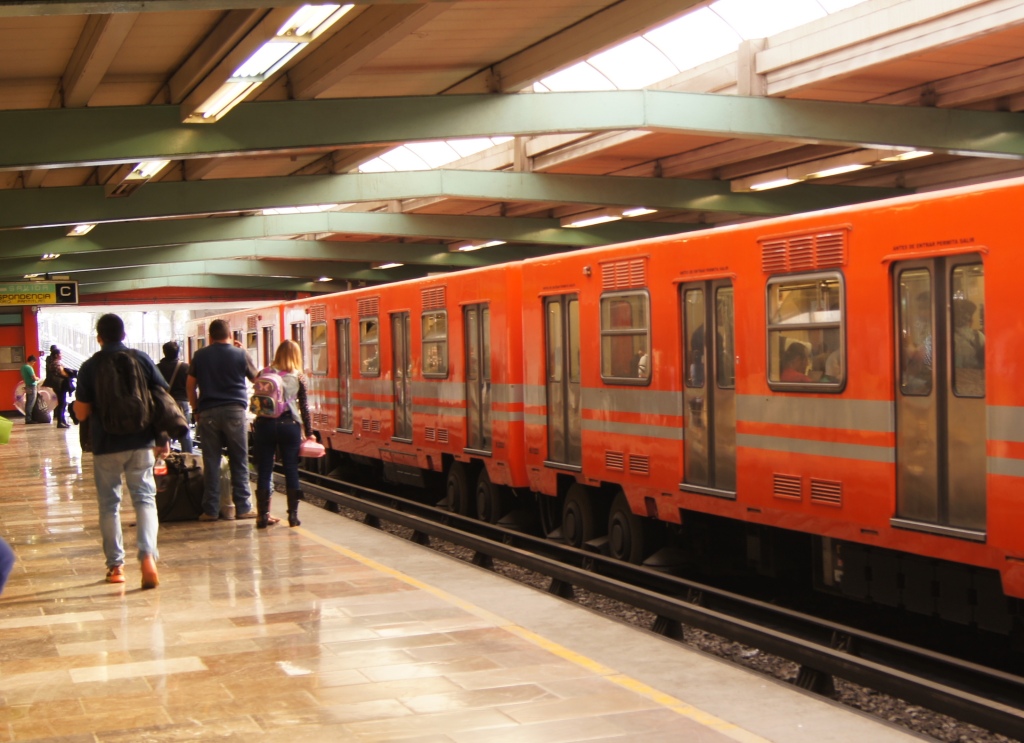
Buses to nearby cities
Buses go from the Mexico City airport to the nearby cities of Puebla, Cuernavaca, Querétaro, Toluca, and more. Most run between 6-7 AM until 10 PM.
To find the buses in either terminal, once you leave customs follow the signs for transporte foráneo (ground transportation) with a little bus icon next to it.

In Terminal 1, take a left after you leave the customs area and follow the signs. You’ll take another left, go up a motorized ramp to the second floor, pass a food court, go down a hallway, and you’ll see desks for the different destinations.
In Terminal 2, finding the bus station is easier—take a right out of customs and just follow the signs straight on. It’s on the same floor and looks more like a typical bus station than the one in Terminal 1.
Yes, you can buy tickets online beforehand, but I don’t recommend this in case your flight is late. I have never seen a bus sell out, but if this happens the worst thing would be to wait for the next one.
You can check schedules for four major destinations on the bus company websites:
To Puebla: Estrella Roja
To Cuernavaca: Pullman de Morelos
To Toluca: Caminante
To Querétaro: Primera Plus
Departing
Once you’ve been in Mexico City for a while, you’ll know whether there’s a metrobus or metro stop near your hotel that you can take back to the airport once it’s time to leave. If you want to take a taxi, have the hotel call one for you. Waving down taxis on the street in Mexico City isn’t safe.
Make sure you know which terminal your flight departs from (see above), and follow the standard advice for international flights—arrive at least three hours early, although if your boarding passes are printed and you aren’t checking luggage, an hour is probably enough. You don’t have to take off your shoes at security, so it typically moves faster than in places like the U.S.
More good news is that you can buy a beer from a convenience store near the departure gates and drink it in the waiting area for your flight—you don’t have to get overcharged at a restaurant.
Once again, be sure that you have the departure portion of the tourist card that was stamped when you arrived, or be prepared to pay the fine.
Don’t buy tequila or other booze (mezcal, Kahlúa, or good Central American rum like Flor de Caña) at the duty free shop. It’s cheaper at an average grocery, liquor or convenience store in the city, but definitely not at a specialty shop in a tourist area. Put the bottles in your checked luggage, and check the requirements of your home country about how much you can bring back.
The same goes for souvenirs. Don’t wait for the airport, where they are flagrantly overpriced. The best place for souvenirs in Mexico City, by the way, is the Ciudadela Market.
Once you’re on the plane, look out the window for some great views, and not only of the city, but of the smoking cone of the nearby volcano Popocatépetl.
Finally, take a moment of appreciation for an airport in a major city that’s only 30 minutes from downtown.


